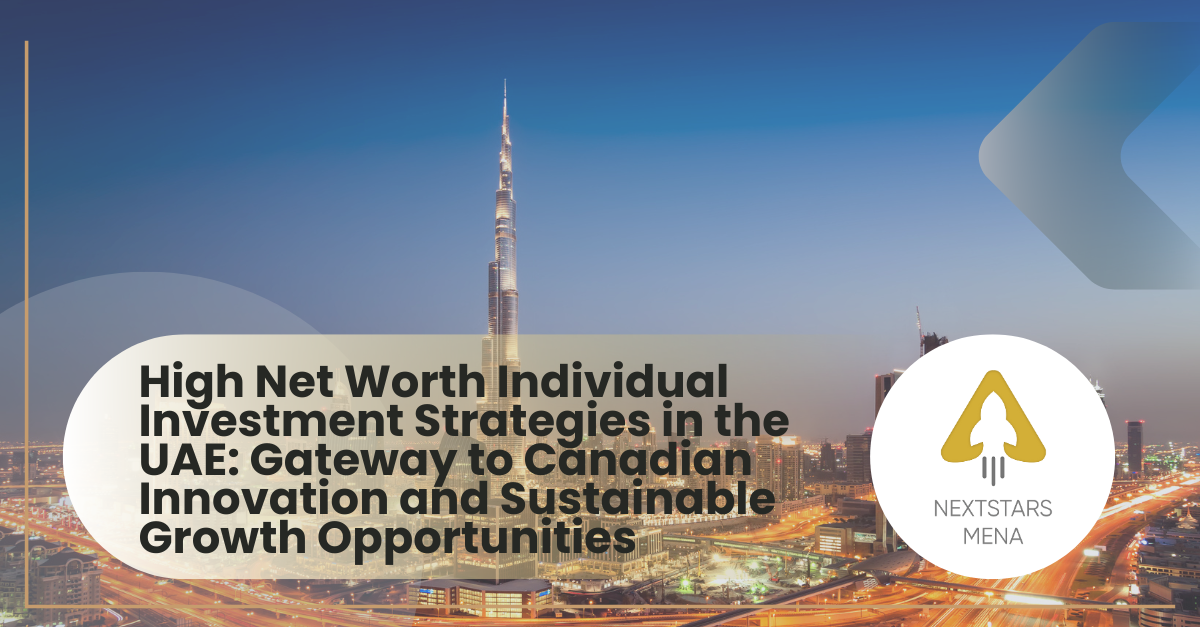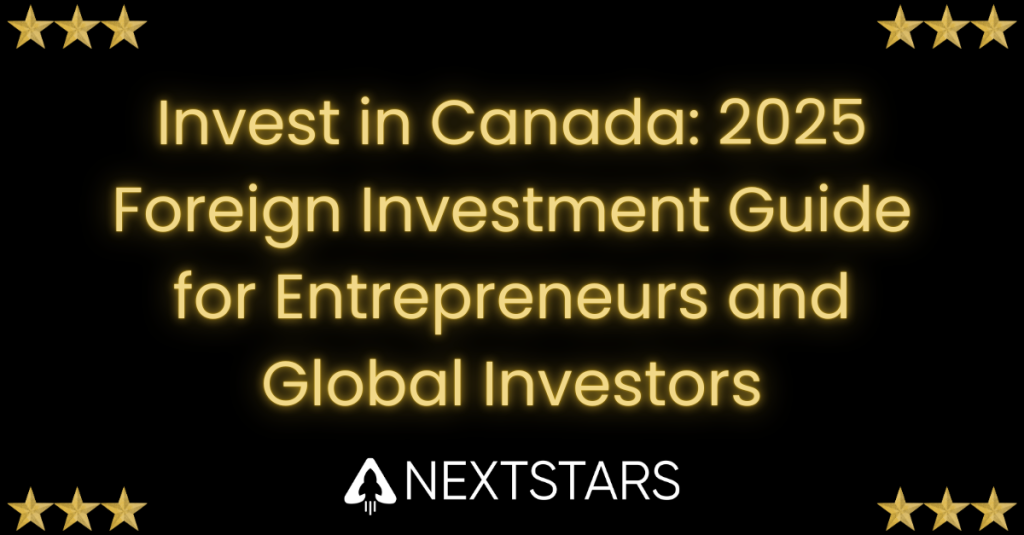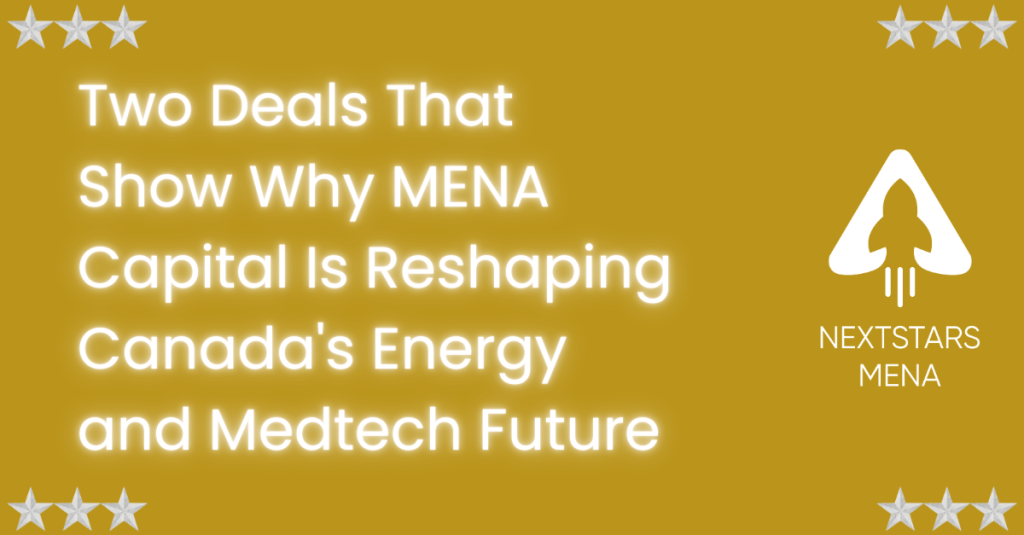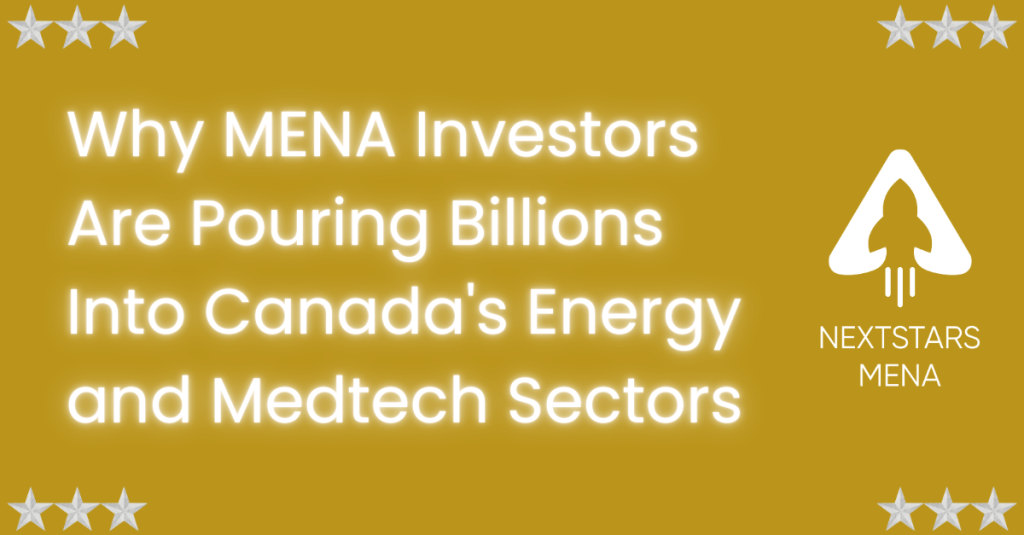Executive Summary
The United Arab Emirates stands as the undisputed wealth management hub of the Middle East, with Dubai and Abu Dhabi ranking as the world’s #1 and #5 destinations for High Net Worth Individuals (HNWIs) respectively. With 81,200 millionaires in Dubai alone and projected wealth under management reaching $1.5 trillion by 2028, the UAE represents one of the most dynamic wealth ecosystems globally.
The convergence of UAE capital seeking global diversification with Canada’s leadership in clean technology, artificial intelligence, and resource innovation creates unprecedented partnership opportunities. Despite bilateral trade reaching $3.4 billion in 2024, the absence of a Comprehensive Economic Partnership Agreement (CEPA) between the nations leaves significant potential untapped. UAE sovereign wealth funds, managing over $2.49 trillion collectively, are actively seeking opportunities in sectors where Canada excels: renewable energy, AI infrastructure, sustainable agriculture, and critical minerals.
For UAE HNWIs and family offices, Canada offers unique advantages combining North American market access, world class innovation ecosystems, and strategic positioning for both resource and technology investments. The alignment between UAE’s economic diversification goals under Vision 2030 and Canada’s strengths in sustainable technology creates natural synergies for transformative partnerships.
Part I: UAE’s HNWI Investment Landscape
Current Market Dynamics
The UAE has experienced remarkable wealth accumulation, with Dubai’s millionaire population doubling over the past decade to reach 81,200 HNWIs, accompanied by 237 centimillionaires and 20 billionaires. This growth trajectory positions the UAE as the world’s premier wealth magnet for the third consecutive year, attracting 6,700 new millionaires in 2024 alone.
Strategic Wealth Hub Characteristics:
- Global Connectivity: Strategic position bridging Asia, Europe, and Africa
- Tax Optimization: Zero personal income tax, no capital gains tax, no inheritance tax
- Political Stability: Ranked among the safest countries globally with Abu Dhabi consistently rated the world’s safest city
- Regulatory Innovation: DIFC houses over 410 wealth and asset management firms
- Golden Visa Program: Attractive residency pathways for investors and entrepreneurs
Wealth Distribution and Growth Patterns:
Dubai: The commercial capital leads with diverse wealth sources:
- Real estate transactions exceeded $173 billion in 2023
- Technology and fintech sector experiencing exponential growth
- Tourism and hospitality driving service sector wealth
- Free zones attracting international business headquarters
Abu Dhabi: The capital leverages sovereign wealth and energy resources:
- Home to ADIA, Mubadala, and ADQ managing combined assets over $2 trillion
- Focus on technology, healthcare, and industrial diversification
- Growing emphasis on sustainability and renewable energy
Investment Preferences of UAE HNWIs
Technology and Innovation Focus
UAE HNWIs demonstrate pronounced interest in technology investments, particularly:
- Artificial Intelligence: MGX’s $100 billion fund for AI infrastructure and semiconductors
- Digital Assets: Growing acceptance of cryptocurrency and blockchain technologies
- Fintech Innovation: Investment in digital banking and payment platforms
- Data Centers: Strategic investments in digital infrastructure across global markets
The technology focus reflects both wealth preservation through innovation exposure and alignment with national economic diversification strategies.
Real Estate and Infrastructure
Real estate remains a cornerstone of HNWI portfolios:
- International Diversification: Properties in London, New York, Singapore, and emerging markets
- Luxury Residential: Premium properties in global gateway cities
- Commercial Real Estate: Office buildings, retail centers, and logistics facilities
- Infrastructure Projects: Participation in airports, ports, and transportation networks
In 2024, incoming HNWIs invested $4.4 billion in Dubai property alone, representing 76% year over year growth.
Sustainable and Impact Investing
A fundamental shift toward sustainable investing characterizes current HNWI strategies:
- Renewable Energy: Solar, wind, and hydrogen projects globally
- Green Bonds: Participation in sustainable debt instruments
- ESG Integration: Environmental, social, and governance criteria in investment decisions
- Climate Technology: Investments in carbon capture, clean transportation, and sustainable agriculture
This shift aligns with UAE’s commitment to achieving net zero by 2050 and positioning as a global sustainability leader.
Alternative Investments
Sophisticated UAE investors increasingly allocate to alternatives:
- Private Equity: Direct investments and fund participation
- Venture Capital: Focus on technology and innovation startups
- Hedge Funds: Diversification through absolute return strategies
- Commodities: Strategic positions in precious metals and energy
Family offices managing over $500 billion in Middle Eastern assets demonstrate particular interest in private markets offering higher returns and portfolio diversification.
Sovereign Wealth Fund Leadership
UAE’s sovereign wealth funds profoundly influence HNWI investment patterns:
Abu Dhabi Investment Authority (ADIA):
- $993 billion in assets under management
- Global diversification across 24+ asset classes
- Founding member of One Planet Sovereign Wealth Funds
- Focus on climate conscious investments and renewable energy
Mubadala Investment Company:
- $302 billion in assets
- Strategic investments in technology, healthcare, and renewable energy
- Masdar subsidiary leading global clean energy projects
- Partnerships with global tech giants and innovation leaders
ADQ (Abu Dhabi Developmental Holding Company):
- $235 billion in assets
- Focus on domestic economic development and international expansion
- Investments in food security, healthcare, and logistics
- Strategic partnerships in emerging markets
These institutions not only manage sovereign wealth but also co invest with private HNWIs, creating powerful investment consortiums that shape global markets.
Part II: Canada UAE Economic Relations
Bilateral Trade and Investment Framework
Canada and the UAE maintain robust and growing economic relations, with two way merchandise trade valued at $3.4 billion in 2024, marking 24% year over year growth following 14% growth in 2023.
Key Canadian Exports to UAE ($2.6 billion):
- Aerospace products (19% of exports)
- Motor vehicles and parts (16%)
- Agricultural products, particularly vegetables and cereals (11%)
- Machinery and equipment
- Technology and telecommunications
Strategic UAE Exports to Canada ($800 million):
- Iron and steel products (24% of imports)
- Raw iron and steel (23%)
- Aluminum products (8%)
- Petrochemicals
- Precious stones and metals
Service Trade: Commercial services trade totaled $388 million in 2023, with significant potential for growth in:
- Financial services
- Technology and digital services
- Engineering and construction
- Education and training
- Healthcare services
Investment Relations and Capital Flows
UAE capital has established significant presence in Canada:
Major UAE Investments in Canada:
- DP World: Operating multiple ports in western and eastern Canada
- Abu Dhabi International Petroleum Investment Company (IPIC): Investments in chemical and plastics sectors
- Real Estate: Significant holdings in Toronto, Vancouver, and Montreal commercial properties
- Infrastructure: Participation in energy and transportation projects
Canadian Presence in UAE: Over 150 Canadian companies maintain operational presence in the UAE, focusing on:
- Energy and renewable technology
- Information and communications technology
- Infrastructure development
- Healthcare services
- Education and training
- Retail and consumer goods
Strategic Cooperation Frameworks
Recent developments strengthen bilateral relations:
Artificial Intelligence MOU (October 2025): Canada and UAE signed agreement to boost collaboration in:
- AI research and development
- Data center infrastructure
- Technology transfer
- Talent exchange programs
Defence and Security Cooperation:
- Defence Cooperation Arrangement between governments
- RCMP and Abu Dhabi Police memorandum of understanding
- Canadian Space Agency and UAE Space Agency collaboration
Humanitarian Partnership: Letter of Cooperation supporting Afghan refugee resettlement demonstrates shared values and operational collaboration.
CEPA Potential
While the UAE has signed Comprehensive Economic Partnership Agreements with 27 countries, notably absent is an agreement with Canada. Given UAE’s ambitious target to increase non oil foreign trade to $1.1 trillion by 2031, a Canada UAE CEPA presents significant opportunities:
Potential Benefits:
- Tariff elimination on key products
- Enhanced market access for services
- Investment protection and promotion
- Regulatory cooperation and standards harmonization
- Simplified trade procedures
The UAE’s existing CEPA network demonstrates the transformative potential, with agreements targeting:
- India: $100 billion trade by 2027
- Turkey: $40 billion by 2028
- Indonesia: $10 billion by 2027
Part III: Canadian Investment Opportunities for UAE HNWIs
1. Clean Technology and Renewable Energy
Canada’s position as the world’s #2 cleantech ecosystem with 2,400+ companies offers compelling opportunities aligned with UAE’s sustainability ambitions.
Green Hydrogen and Clean Fuels
Canadian expertise in hydrogen production, storage, and distribution directly supports UAE’s energy transition:
Electrolyzer Technology: Canadian companies lead in developing next generation electrolysis systems essential for green hydrogen production. With UAE’s Masdar targeting 1 million tonnes of green hydrogen annually by 2030, Canadian technology partnerships offer critical capabilities.
Carbon Capture and Utilization: Companies like Carbon Engineering (acquired for $1.1 billion) and Svante provide technologies essential for industrial decarbonization, particularly relevant for UAE’s oil and gas sector transformation.
Renewable Energy Integration: Canadian expertise in grid management, energy storage, and renewable optimization supports UAE’s target of 50% clean energy by 2050.
Sustainable Aviation Fuels: Canadian companies developing SAF technologies align with UAE’s aviation hub status and Emirates’ commitment to sustainable flight.
2. Artificial Intelligence and Data Infrastructure
The convergence of UAE’s $100 billion AI funds with Canadian AI leadership creates exceptional opportunities:
AI Research and Development: Toronto and Montreal’s position as global AI hubs offers access to:
- Leading research institutions and talent
- Established AI companies seeking scale up capital
- Early stage ventures with breakthrough technologies
- Applied AI solutions for healthcare, finance, and logistics
Data Center Infrastructure: Canadian advantages include:
- Renewable energy powered facilities
- Cool climate reducing cooling costs
- Stable political and regulatory environment
- Strategic location for global data routing
Quantum Computing: Canada’s leadership in quantum technologies positions investors for next generation computing breakthroughs with applications in:
- Financial modeling and risk assessment
- Drug discovery and healthcare
- Cryptography and security
- Materials science and engineering
3. Critical Minerals and Sustainable Resources
Canada’s vast mineral resources align with UAE’s industrial ambitions:
Battery Materials and Energy Storage:
- Lithium, cobalt, and nickel for electric vehicle batteries
- Graphite and rare earth elements for electronics
- Recycling technologies for circular economy
- Energy storage systems for renewable integration
Sustainable Mining Technologies:
- Autonomous mining equipment and systems
- Environmental remediation and water treatment
- Digital twins and predictive maintenance
- Low impact extraction methods
Strategic Metals for Technology:
- Semiconductors and electronic components
- Aerospace and defense materials
- Medical devices and equipment
- Renewable energy infrastructure
4. Agtech and Food Security
With food security a national priority for UAE, Canadian agricultural innovation offers strategic value:
Controlled Environment Agriculture:
- Vertical farming systems for urban food production
- Greenhouse technologies optimizing water usage
- LED lighting and climate control systems
- Automated growing and harvesting technologies
Precision Agriculture:
- Satellite imaging and drone monitoring
- IoT sensors and data analytics
- AI driven crop optimization
- Water conservation technologies
Alternative Proteins:
- Plant based meat alternatives
- Cellular agriculture and lab grown meat
- Insect protein production
- Fermentation technologies
Agricultural Biotechnology:
- Drought resistant crop varieties
- Biological pesticides and fertilizers
- Soil health optimization
- Yield enhancement technologies
5. Healthcare and Life Sciences
Healthcare innovation represents a strategic priority for both nations:
Digital Health Platforms:
- Telemedicine and remote patient monitoring
- AI powered diagnostics and treatment planning
- Electronic health records and interoperability
- Mental health and wellness applications
Biotechnology and Pharmaceuticals:
- Drug discovery and development
- Personalized medicine and genomics
- Vaccine development and production
- Biologics and biosimilars
Medical Devices and Equipment:
- Diagnostic imaging technologies
- Surgical robotics and automation
- Wearable health monitors
- Point of care testing devices
Healthcare Infrastructure:
- Hospital management systems
- Supply chain optimization
- Medical education platforms
- Healthcare analytics and population health
Part IV: Strategic Entry Pathways for UAE Investors
Canada’s Startup Visa Program
The Startup Visa Program offers unique advantages for UAE entrepreneurs and investors seeking North American expansion while maintaining global operations.
Program Structure and Benefits:
- Permanent residence for entrepreneurs and families
- No minimum net worth requirements
- Processing times typically 12 to 18 months
- Access to Canadian healthcare and education
- Pathway to citizenship after 3 years residency
- Dual nationality permitted with UAE
Investment Pathways:
Venture Capital Funds ($200,000 minimum):
- Investment from 40+ designated Canadian VC funds
- Professional portfolio management
- Access to Canadian innovation ecosystem
- Co investment opportunities
- Exposure to diverse technology sectors
Angel Investor Groups ($75,000 minimum):
- More accessible entry threshold
- Direct involvement in investment decisions
- Access to 25+ designated angel groups
- Mentorship from experienced entrepreneurs
- Network effects and deal flow access
Business Incubators:
- No capital requirement
- Comprehensive business support services
- Access to 60+ designated incubators including platforms like NextStars specializing in climate technology and global expansion
- Validation of business model
- Canadian market entry support
Sovereign Wealth Fund Co Investment
UAE sovereign wealth funds’ Canadian activities create co investment opportunities for private HNWIs:
Direct Co Investment:
- Participation alongside ADIA, Mubadala, or ADQ in Canadian deals
- Leveraging sovereign fund due diligence and negotiating power
- Access to larger scale investments
- Risk mitigation through institutional partnership
Fund Investments:
- Canadian funds with UAE sovereign wealth fund participation
- Sector specific vehicles in technology, energy, or infrastructure
- Growth equity funds targeting established companies
- Venture capital funds for early stage exposure
Syndicate Participation:
- Joining investment syndicates led by sovereign wealth funds
- Access to proprietary deal flow
- Shared due diligence and monitoring costs
- Network expansion opportunities
Corporate Venture and Strategic Partnerships
UAE corporations can establish strategic Canadian presence:
Corporate Venture Capital:
- Establishing Canadian investment arms
- Direct investments in relevant technologies
- Strategic acquisitions of Canadian companies
- Partnership with Canadian accelerators
Joint Ventures:
- Technology development partnerships
- Market entry collaborations
- Manufacturing and production ventures
- Research and development initiatives
Technology Transfer:
- Licensing Canadian innovations for MENA deployment
- Adaptation of technologies for regional markets
- Distribution and commercialization agreements
- IP development partnerships
Real Estate and Infrastructure
Canadian real estate offers stability and growth for UAE investors:
Commercial Real Estate:
- Office buildings in Toronto, Vancouver, Montreal
- Retail properties in growing urban centers
- Industrial and logistics facilities
- Mixed use developments
Residential Investments:
- Purpose built rental housing
- Student housing near universities
- Senior living facilities
- Affordable housing projects with government support
Infrastructure Projects:
- Renewable energy generation
- Transportation networks
- Digital infrastructure
- Social infrastructure (hospitals, schools)
Real Estate Investment Trusts (REITs):
- Liquid exposure to Canadian real estate
- Diversified portfolio access
- Professional management
- Stable dividend income
Part V: Risk Considerations and Mitigation Strategies
Market and Regulatory Risks
Foreign Investment Review:
- Investment Canada Act review for significant acquisitions
- National security considerations for sensitive sectors
- Provincial regulations and approvals
- Competition law compliance
Mitigation: Engage experienced Canadian legal counsel early in transaction planning.
Currency Management:
- CAD/USD volatility affecting returns
- AED peg to USD providing some stability
- Translation risk for financial reporting
- Transaction timing considerations
Mitigation: Implement hedging strategies using forwards, options, or natural hedges through revenue matching.
Tax Implications:
- Canadian federal and provincial taxation
- Withholding taxes on dividends and interest
- Capital gains tax considerations
- Estate tax planning requirements
Mitigation: Utilize Canada UAE tax treaty benefits and structure investments efficiently.
Operational Challenges
Geographic and Cultural Factors:
- Distance and time zone differences (11 hour difference)
- Bilingual requirements in certain provinces
- Different business practices and expectations
- Seasonal considerations affecting operations
Mitigation: Establish local presence with trusted Canadian partners and advisors.
Talent and Management:
- Competition for skilled workers
- Immigration requirements for foreign workers
- Management oversight from distance
- Cultural integration challenges
Mitigation: Develop hybrid management structures combining UAE oversight with Canadian execution.
Market Competition:
- Established domestic and international competitors
- Rapid technological change
- Regulatory evolution
- Customer acquisition costs
Mitigation: Focus on differentiated value propositions leveraging UAE strategic advantages.
Strategic Risk Management
Diversification Strategies:
- Spread investments across sectors and stages
- Geographic diversification within Canada
- Mix of public and private investments
- Timeline diversification with staged deployments
Due Diligence Excellence:
- Comprehensive financial and legal review
- Technical and market validation
- ESG and reputational assessment
- Cultural fit evaluation
Partnership Structures:
- Joint ventures to share risk and expertise
- Minority investments with governance rights
- Convertible instruments for flexibility
- Earnout structures aligning interests
Exit Planning:
- Multiple exit scenarios from inception
- Strategic buyer identification
- IPO readiness preparation
- Secondary market options
Part VI: Implementation Roadmap
Phase 1: Strategic Foundation (Months 1-6)
Market Intelligence Development
- Engage Trade Commissioner Service in Dubai/Abu Dhabi and major Canadian cities
- Connect with Canada UAE Business Council and chambers of commerce
- Identify sector specific opportunities aligned with UAE priorities
- Assess competitive landscape and market dynamics
Relationship Building
- Establish connections with designated Startup Visa organizations
- Build relationships with Canadian funds and co investors
- Engage legal, tax, and advisory firms
- Connect with UAE investors active in Canada
Initial Planning
- Define investment thesis and target sectors
- Establish Canadian entity structure
- Develop governance and oversight framework
- Allocate initial resources and budget
Phase 2: Market Entry (Months 6-12)
Pilot Investments
- Execute 2 to 3 initial investments to establish presence
- Focus on sectors with clear UAE Canada synergies
- Consider Startup Visa Program for entrepreneurial ventures
- Document learnings and refine approach
Operational Establishment
- Set up Canadian operations if required
- Implement reporting and monitoring systems
- Establish banking and financial relationships
- Build local team or advisory board
Network Development
- Join relevant industry associations
- Participate in Canadian tech ecosystem events
- Attend bilateral business forums
- Develop media presence and thought leadership
Phase 3: Scaling Operations (Months 12-24)
Portfolio Expansion
- Increase investment pace based on initial success
- Explore co investment with sovereign wealth funds
- Consider larger ticket size investments
- Develop sector specialization
Value Creation Initiatives
- Support portfolio companies with MENA market access
- Facilitate strategic partnerships
- Provide operational expertise
- Enable customer introductions
Strategic Partnerships
- Formalize partnerships with Canadian institutions
- Develop co investment vehicles
- Create technology transfer arrangements
- Build bilateral business bridges
Phase 4: Sustainable Growth (24+ Months)
Portfolio Optimization
- Regular portfolio review and rebalancing
- Exit mature investments
- Reinvest proceeds strategically
- Develop permanent capital strategies
Market Leadership
- Contribute to Canada UAE economic dialogue
- Support bilateral trade initiatives
- Mentor emerging investors and entrepreneurs
- Share expertise through speaking and writing
Institutional Development
- Consider permanent Canadian presence
- Develop next generation engagement
- Create educational initiatives
- Build lasting institutional relationships
Legacy Building
- Establish philanthropic initiatives
- Support innovation ecosystems
- Create scholarship programs
- Foster entrepreneurship development
Conclusion
The UAE’s position as the global wealth management capital, combined with Canada’s innovation leadership and resource abundance, creates one of the most compelling yet underexploited investment corridors in the global economy. With Dubai and Abu Dhabi attracting unprecedented wealth inflows and Canadian sectors aligning perfectly with UAE’s economic diversification goals, the timing for strategic engagement has never been more optimal.
For UAE HNWIs and family offices, Canada offers far more than traditional investment returns. It provides participation in transformative technologies addressing global challenges, from climate change to food security to healthcare innovation. The alignment between UAE’s Vision 2030 ambitions and Canada’s strengths in clean technology, AI, and sustainable resources creates opportunities for value creation that transcend purely financial metrics.
The absence of a formal CEPA between the nations, while limiting, also presents opportunity. Early movers can establish strategic positions before inevitable closer economic ties drive increased competition and valuations. The existing frameworks, from the Startup Visa Program to sectoral cooperation agreements, provide sufficient structure for sophisticated investors to build meaningful portfolios.
UAE sovereign wealth funds’ growing presence in Canadian markets validates the opportunity while providing potential co investment partnerships for private investors. Their focus on technology, renewable energy, and infrastructure aligns with sectors offering the most compelling opportunities for private capital deployment.
Success requires sophisticated understanding of both markets’ dynamics. The geographic distance, regulatory differences, and cultural considerations demand careful planning and local partnerships. However, for investors committed to building bridges between complementary economies, the rewards extend beyond financial returns to include strategic positioning in critical future industries.
As the global economy transitions toward sustainability and digitalization, the UAE Canada investment corridor represents a strategic axis connecting Middle Eastern capital with North American innovation. UAE investors who recognize and act on this opportunity will not only generate superior returns but also contribute to both nations’ economic transformation and sustainable development goals.
The convergence of UAE wealth seeking global diversification with Canadian innovation requiring patient capital creates a unique moment in economic history. For forward thinking UAE investors, Canada represents not just another market but a gateway to the industries and technologies that will define the next generation of global prosperity.
Through strategic deployment of capital, thoughtful partnership development, and commitment to long term value creation, UAE investors can successfully leverage Canadian opportunities while contributing to the continued evolution of one of the world’s most dynamic bilateral relationships. The future belongs to those who build bridges between complementary strengths, and the UAE Canada corridor stands ready to become one of the defining investment partnerships of the coming decade.
Read our articles here.
This report provides general information about investment opportunities and should not be construed as investment advice. Prospective investors should conduct their own due diligence and consult with qualified advisors before making investment decisions.





